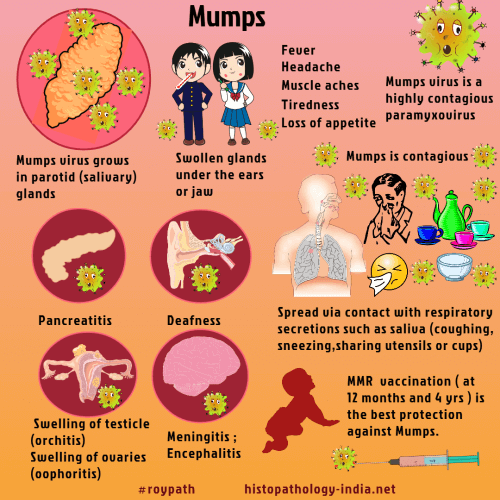|

Custom Search
|
|
Infectious Disease Online Pathology of Mumps
|
|
Mumps is an acute but usually mild viral infection of childhood, characterized by swollen and inflamed salivary glands (most often the parotids). Less often the virus attacks the pancreas, ovaries, testes, and other organs. Mump virus is a highly contagious paramyxovirus that is commonly transmitted in respiratory droplets. A vaccine made from attenuated live mumps virus has reduced the frequency. Most adults are immune. Nonimmune adults who acquire the infection may have a painful and debilitating illness. The incubation period is 2 to 4 weeks, after which fever, headache, malaise, and swelling and inflammation of the salivary glands follow. Swelling and other acute symptoms usually subside within 2 weeks. Mumps is usually diagnosed clinically from swollen salivary glands and confirmed by finding rising titers to mumps virus in the serum of convalescent patients. The histologic features of the swollen parotid glands include diffuse interstitial edema and an inflammatory infiltrate composed of histiocytes, lymphocytes, and plasma cells. This infiltrate may compress the acini and ducts, and the exudate may also spill into the epithelial layers. Other organs may be affected whether the salivary glands are swollen or not. The most common complication is a painful orchitis with parenchymal hemorrhage. The tunica albuginea tightly contains the swollen testis, which may result in necrosis of seminiferous tubules, local hemorrhage, and microinfarctions sometimes leaving permanent fibrous scars. Mumps orchitis is usually unilateral and thus rarely causes male sterility. Infection of the pancreas leads to pancreatitis, characterized by necrosis of pancreatic and fat cells. Up to 10% of patients can develop aseptic meningitis ; a less common but more serious complication is encephalitis, which can result in death or disability. Hemagglutinin-neuraminidase (HN) is the major surface antigen and is known to elicit neutralizing antibodies. Traditional mumps virus detection methods are often insensitive, lengthy, and cumbersome. Early serological diagnosis often relies on detection of anti-mumps IgM, which may be absent in the first 10 days of illness. Some laboratories use molecular methods that are based on nested polymerase chain reaction. According to one study - Real-time PCR on oral samples was considered to be the investigation of choice for mumps infection. Mumps virus detection in urine by any of the PCRs used was less successful. Real-time PCR on CSF samples was considered a promising adjunct for diagnosis of mumps meningitis, especially in an age group with high incidence of mumps. Countries already using mumps vaccine should monitor immunization coverage and establish routine mumps surveillance with investigation of outbreaks. Where mumps is targeted for elimination, countries need to add a second dose of mumps vaccine for children, keeping in mind that the disease may still occur in susceptible adults.
|
|
|
Copyright © 2022 histopathology-india.net



